On March 11, 2020, nearly two months after announcing a global health emergency, the World Health Organization declared the COVID-19 outbreak a pandemic. The disease originated in China but has spread to more than 150 countries and territories, with major outbreaks in mainland China, Europe, Iran, the United States and South Korea, among others. By March 16th more than 170,000 cases of people infected have been reported, and over 6,500 people have died from the disease, with 77,000 recovered. In North America, states of emergencies are being declared as restaurants, bars, sports facilities and recreation centers are shut down, grocery stores emptied, stock markets roil and students, parents and workers stay home in self imposed quarantine.
We are currently undergoing a tipping point event.
During this pandemic, the Corona virus is showing the incredible power of individuals, governments and businesses to rapidly respond to and change harmful behaviors and habits in the face of a widespread global threat . As the crisis continues, as people stop travelling and oil crashes, they provide very real data and potentially long term lasting impacts on behaviors that can lead us towards healthier and regenerative ways of living.
Around the world after the initial shock wears off local communities are re-prioritizing what is important as a society, people are stepping up, and everyone is exploring how to ensure greater interconnections, resiliency and healthier ways of living and protecting the most vulnerable as we enter into a deep period of unknowing and uncertainty.
Right now, Governments and markets right now are moving trillions of dollars and re-allocating billions of dollars. Our funding and priorities are shifting as the way that our societies communicate, interact and what we call normal is redefined. Many of these steps also provide a picture of what a coordinated, decentralized and global effort to halt climate change may look like.
In times of shock like this, we have an incredible power to create new paradigms, and a new normal. As individuals, communities and businesses mobilize around the world, let’s assess what was working and what wasn’t – and use this as a way to build healthier ways of living, of governing and protecting ourselves, and cut out what wasn’t.
As the fundamental balance of the world economy is temporarily upended, if leveraged correctly can be a brief moment to correct the course towards much healthier cultures and ways of living for the entire planet.
Carbon Emissions around the world are plummeting
Since taking affect, COVID 19 has brought much of the traditional global economy, such as deep sea tankers, airlines, factories, manufacturing, day to day traffic, cruise ships – to a standstill, having far reaching effects.

In China, carbon emissions dropped by least 100 million metric tons in the first two weeks of March, according to a study published on Wednesday by the Center for Research on Energy and Clean Air (CREA) in Finland. Construction activity has slowed, which has meant reduced demand for steel and other materials. Oil refineries are producing less fuel than usual as cargo trucks sit idle and the number of flights has dropped by about 13,000 per day.
This has led to an overall reduction of 15% to 40% of production in China over different industrial sectors. China’s nitrogen dioxide emissions, a key indicator of fossil fuel use – generally diesel in vehicles and power plants, fell 36 percent in the week. The drop has led to a sharp demand in the drop in demand for coal and oil. Daily power generation at coal power plants was at a four-year low compared with the same period last year, while steel production has sunk to a five-year low and oil production in Shandong province is at it’s lowest level since 2015.
So what is the overall impact of these changes? China, the world’s biggest carbon polluter (it pumps more greenhouse gases into the atmosphere than the US and EU combined, has likely wiped out around a quarter or more of it’s CO2 emissions in a span of two weeks.
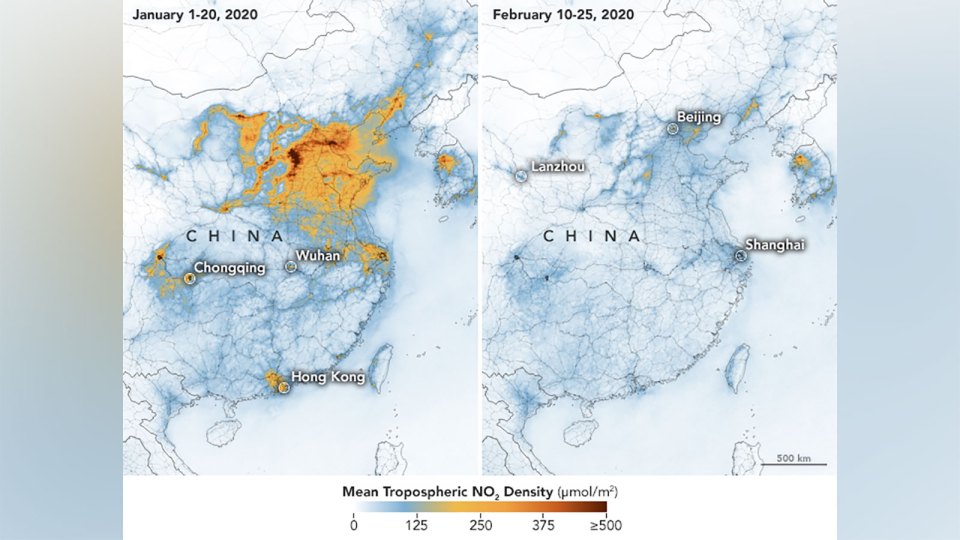
China is such a huge industrial polluter that even a temporary dip like this is significant: The three-week decline is roughly equal to the amount of carbon dioxide that the state of New York puts out in a full year (about 150 million metric tons).
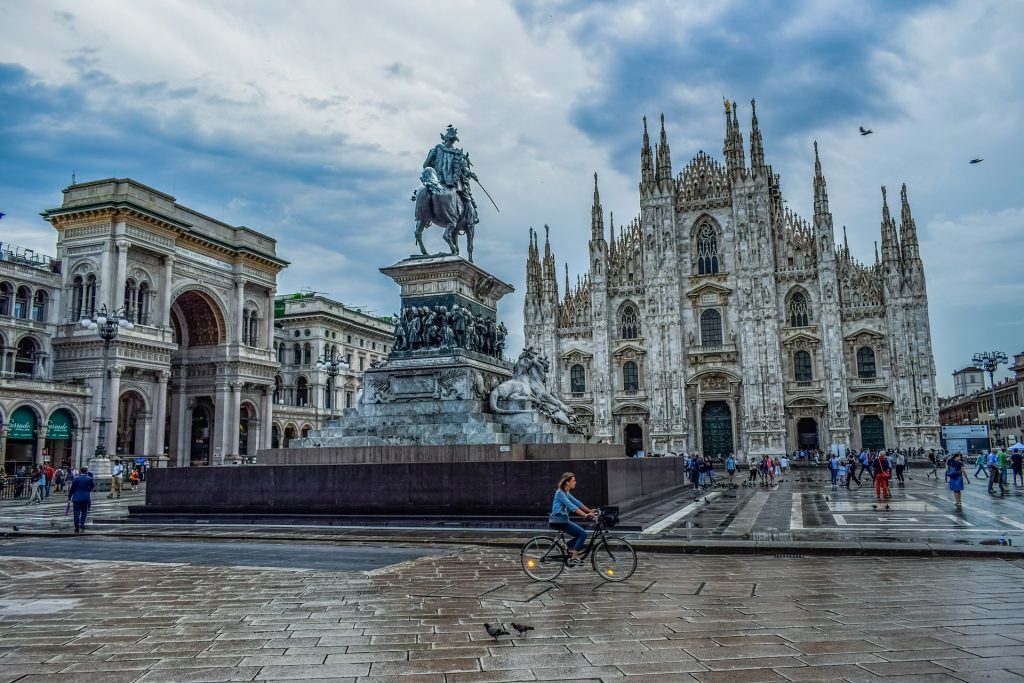
In Italy, between Jan. 1 and March 12, concentrations of nitrogen dioxide, or NO2, fell drastically, especially over hard-hit northern Italy. As a proxy, this is largely indicative in a country in which half of the cars in the country burn diesel. In Milan, located in the hardest hit region, the transportation sector produces more than 70 percent of all nitrogen dioxide according to a recent analysis by the European Commission’s Joint Research Center.

In Venice, residents have noted the incredibly clean air, and in a city under constant threat of over tourism, rising seawaters and flooding – for the first time in living memory the canals have turned clear.
“Nature resumes it’s life….how beautiful,” wrote Maria Lanaro. “Marvelous there are even fish that we have the opportunity to see”.
from Venezia Pulita
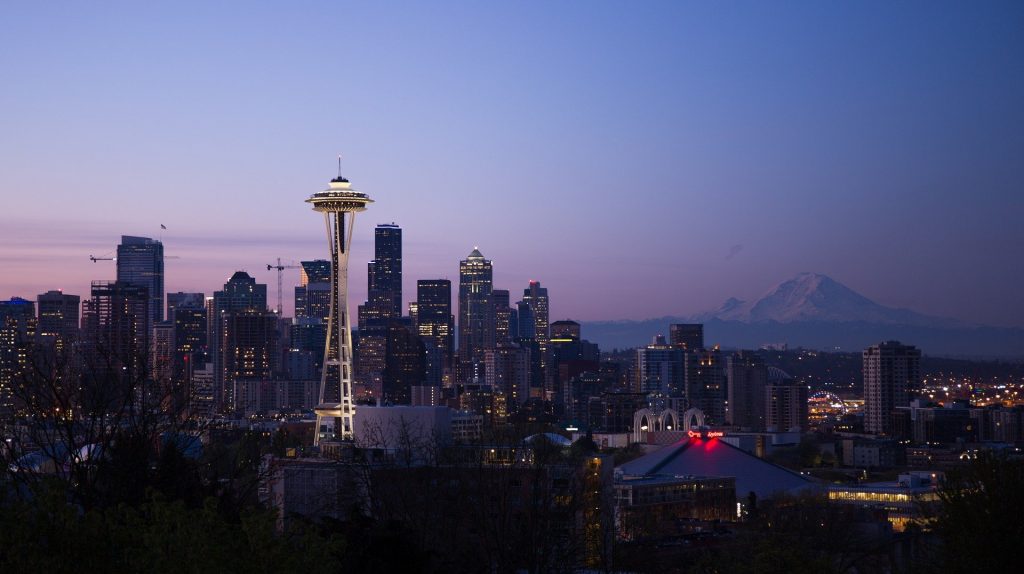
In North America, the carbon emissions from our living come from three activities: travel by plane, cars and eating animal products, with driving being the largest source of emissions for the average American. Studies have shown one round trip flight from New York to London produces as much greenhouse gas emissions as nearly eight years of recycling. In addition, the temporary halt to building construction is huge as about 95% of materials that end up in a landfill each year.
In the United States school closures, event cancellations and work-from-home policies mean millions of people are no longer commuting by car. Some cities such as New York have said that early results show carbon monoxide mainly from cars had been reduced by nearly 50% compared with last year, and overall emissions dropping by as much as 35%.
Much like China, the US economy is stuttering. The stock market has already crashed by more than 30% and in the next several months could see a 20% unemployment rate due to coronavirus according to the US Treasury Secretary Steven Mnuchin. Borders have been closed between the US and Canada, and European leaders have decided to ban non-essential travel to the EU for 30 days.
To put this in context, the United States DJIA has just begun it’s economic decline from all time highs near 30,000 in February. On average, market, which means a drop of more than 20% from recent highs, stocks on average lose 36%, and declines usually last about 299 days, or about 10 months. This all indicates that our global slowdown, as well as our panic and it’s effects are truly just beginning, In the face of a protracted recession, these impacts will only continue to grow.
Oil is at a Precipitous Moment

Meanwhile, oil prices had their biggest one-day crash since the 1991 Gulf War and continue to drop as Saudi Arabia and Russia flood the market with more oil despite the demand for oil is dropping by 435,000 barrels a day compared to a year ago. According to the International Energy Agency and global oil demand is expected to drop by 30% in 2020 from where they were before the pandemic.
Crude oil demand during this quarter will likely register the largest decline on record, larger even than the slump that accompanied the 2008 financial crisis.
Despite this drop in demand, Russia and Saudi Arabia are increasing their output in a move targeting US oil shale producers. US oil producers have become the largest producer of crude oil in the world in the past several years. The massive glut in oil production could reach between 800 million barrels and a staggering 1.3 billion barrels, two to nearly four times larger than the previous biggest glut of 360 million barrels in late 2015-early 2016.
Goldman Sachs predicts oil prices could hit $20 a barrel. Their goal is to drop oil prices so low US shale producers cannot compete. Russia and the United States need prices in the low $40’s while Saudi Arabia needs oil prices of around $82 a barrel to balance its budget. In response, the US government has begun to buy up oil for it’s strategic oil supplies, but oil companies cannot survive in a protracted oil dispute, as both Russia and Saudi Arabia have foreign exchange reserves of more than $400 billion from which to prop up their industries with.
Now is the perfect time for a massive shift in how we get, and use our energy.
U.S. oil output has grown rapidly since 2009, driven by increased output from shale, which hit 7.7 million barrels a day in 2019, according to the U.S. Energy Information Administration. Shale, or tight-oil, production accounted for 63% of U.S. output last year.
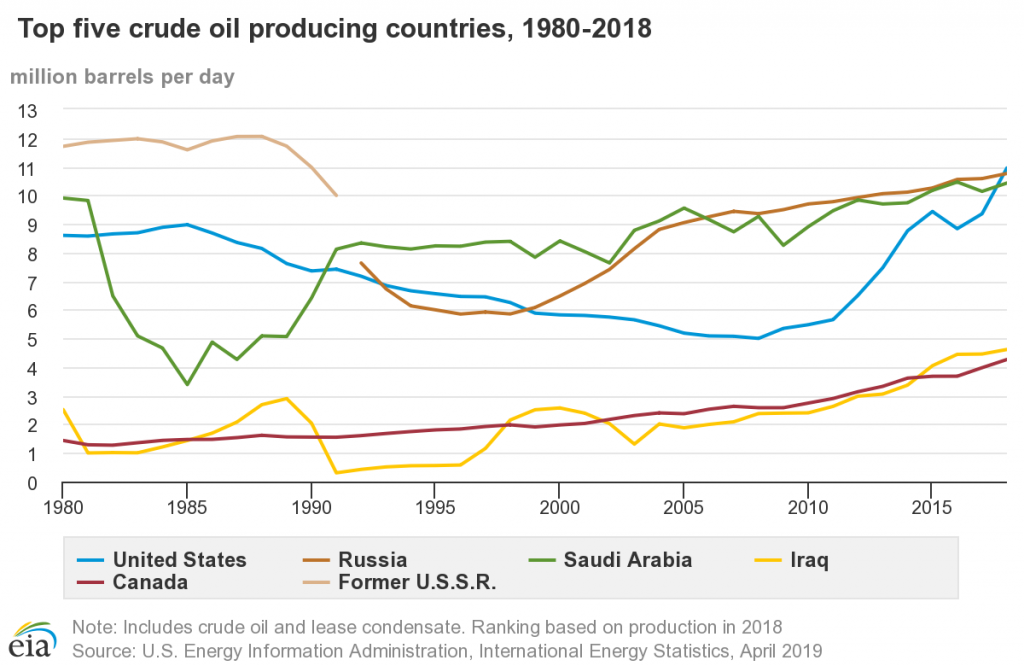
This mean there is a wonderful opportunity to push for wind, solar and transportation methods which not dependent on fossil fuels. If subsidies were shifted and removed from increasingly expensive fuel sources, it could ensure a much higher degree of resiliency and reliance in the face of uncertain global markets.
An easy opportunity for Cities & Counties
Cities have an opportunity to not only talk about transportation and energy grid – but also about fundamental building codes. Building in modular construction in which buildings can be deconstructed and re-used as easily as built – that use LEED standards, use materials which are not harmful to the planet or those living within them, employ green roofs, water capturing and standalone energy generation – are all easy steps that can have a tremendous impact for the future.
As larger centers – to connect green belts into natural corridors, reserving green cover at over 30%, encourage urban gardening, food forests, electrified transportation based on renewable resources, and to focus on livable and walkable cities in which all needs can be met close by are other ways which can increase resiliency, healthy living and preparedness.
Together, we can work together to ensure that the billions of dollars being leveraged to buy hotels and motels to turn into sick beds for patients could be later used for homeless housing and services. To make sure that impact funding is reaching every person impacted, rather than to only the largest companies and corporations. That rather than buying up short term oil reserves to subsidize prices, we shift our spending to renewable energy and decentralized smart and micro grid technology.
Renewable resources also allow for much greater flexibility in microgrid, offgrid and standalone technologies, which in a disaster allow for energies to continue to be produced at the point of generation, rather than needing to be shipped from another locality. Bioregional frameworks can be introduced for independent power generation, as best suited for each, and in ways which are healthier for the planet and those living within them.
The Impact of Mass Gatherings

Another recent, and rapidly accelerating fallout of the disease is the cancellation of major events in sports, the film industry, and other industries, such as music festivals and concerts, technology conferences, fashion shows and sports. Around the world theatres, theme parks, schools and religious centers are shutting down for in person events.
This includes
- Government Summits
- Global Conventions
- Amusement Parks
- Schools
- Parades
- Religious Ceremonies
- Sporting Events
- Music Tours.
- Tourism in general
The Space Mountain ride in Tokyo Disneyland, near Tokyo, Japan Before Corona-virus and after
This list could go on forever, but the impacts add up really quickly. Just a few examples.
Schools: As of 16 March, more than 510 million children and youth are not attending school because of temporary or indefinite country wide school closures mandated by governments in an attempt to slow the spread of COVID-19.
Football: Typical football game days utilize an estimated 4 to 7 MW of power. If it’s in a stadium, the number goes up to around 10 MW of energy at their peak, which means putting as much as 6.9 metric tons of CO2e into the atmosphere, roughly the same as driving over 16,000 miles! Stadiums also generate a large amount of waste: The Tennessee Volunteers [for example] generate over 21 tons of waste per game. With college football teams playing about 7 home games a season, that results in roughly 147 tons of waste generated per season for one university.
But what about the largest stadiums? The 2012 Super Bowl hosted in Indianapolis used roughly 15,000 megawatt hours of electricity. This is enough electricity to power nearly 1,400 average homes in the United States for one year.
The Kaaba at the Grand Mosque in the holy city of Mecca, Saudi Arabia, before Corona-virus and after
Music: According to the Green Tour Guide, roughly 74.4 million tickets were sold for music events around the world according to online service Statista. For a medium-sized gig, attendants use an average of 5kg of CO2 generated in travelling to and from a local event – this means about 372,000 metric tons of CO2 are released. Taken together, this equals roughly 248,000 flights to New York to Berlin, Germany.
Olympics: If the Olympics in Japan are cancelled, it will save additional 470,000 tonnes of CO2. The construction of sporting and support venues and urban infrastructure by itself estimated to generate 1,590,000 tonnes of CO2, and indirect emissions from spectators (international and domestic travel, accommodation, food) are estimated to range from 1,500,000 to 2,500,000 tonnes of CO2eq.
Now is the time to think about ways we can make these greener.
However, these large stadiums and events are also leading the world in some of the most sustainable efforts, and by being huge pinpoints of massive economic investment, can also provide some unique features if implemented correctly.
More players are taking the Carbon Neutral Challenge as presented by the David Suzuki Foundation. One example is more than 500 members of the National Hockey League Players Association purchasing carbon credits through the Montreal-based nonprofit organization Planetair. The credits offset players’ travel emissions, averaging 10 tons per player per season. As a result, the initiative, which involves players from all 30 teams, has offset more than 5,000 tons of carbon – the equivalent of removing 1,000 cars from the road each year, according to the foundation.
Detroit’s Ford Field became the first NFL stadium to hold a 100 percent carbon-neutral game, as the Lions welcomed the Green Bay Packers. A 150,000-tree “carbon sink,” planted as part of a reforestation effort by Detroit-based Carbon Credit Environmental Services, helped offset the more than 1.8 million pounds of greenhouse gas and carbon dioxide used during the game.
Stadiums as centers for mitigating disasters:
Because of the large infrastructure needed to maintain a stadium, their ability to hold tens of thousands of people, and placement in a central location, usually at a hub of mixed transportation types such as roads, trains, light rail and other means, Stadiums are interestingly situated to be prime centers for disaster response in times of emergency. Levi’s Stadium in San Francisco is an interesting example of this which includes a 375 kW solar installation, which produces roughly 468,000 kWh annually, reclaimed potable and non-potable water, geothermal heat pump transfers heat from the sun-drenched ground all around the stadium straight to the hot water supply, 27,000 square-foot green roof with native plant species in addition to the solar panels, and produced using recycled materials with a LEED Gold Certification. The Johan Cruyff Arena in Amsterdam, the home of Ajax, reuses used electric car batteries, charges them up through its system of solar panels and wind turbines, and redistributes the leftover energy to the local neighbourhood. Signal Iduna Park in Dortmund in Germany is disconnected from the electricity network and it has managed to obtain all of its power from solar panels thanks to a new engineering system based on semi-conductors.
A Global Pause to the Cruise Ship Industry

One of the largest industries hit, has been the cruise ship industry. Princess Cruises will halt global operations of its 18 cruise ships for two months, after two of its ships carried passengers who were diagnosed with the coronavirus.The move came after another cruise ship operator, Viking, announced it would also suspend all ocean and river cruises until May 1. Viking has 16 ocean-going ships and more than 70 vessels overall.Later in the day, Virgin Voyages, the new cruise line that is part of Virgin Group, announced that it will delay its inaugural voyage until August 7.
So how much impact does this have? Broadly, the number of cruise ships in the world produce about as much emissions as 1 million cars every day. According to the Global Sustainable Tourism Dashboard, as of 2017 cruise ships produced 21195 kilotons of carbon dioxide. Localized air pollution from sulfur oxide and nitrogen oxide which can cause respiratory problems can get so bad that the air quality on deck compares to the worst 100 cities globally.
And these ships are massive. The typical cruise ship costs about $260 million per ship that can accommodate approximately 500 passengers, to a price tag of around 500 million for one that can hold 2000-3000 passengers. The largest cruise ships cost about $937 million with the largest in the world, with a capacity of 7000 and 2747 cabins coming in at around $1.35 just to build. Daily operating costs, fuel, crew range in the hundreds of thousands of dollars.
This is in addition to the solid waste, and other waste produced as part of their regular operations. For example Royal Caribbean, a single cruise ship line alone uses more than 65 million plastic utensils each year. In 2018 they hosted over 6.1 million passengers costing $9.5 Billion just on operating expenses. Taken together, the combined affect of a global pause to cruise industry will have a large ripple effect in terms of short term sustainability.
Airlines

At any one time, there are a million people airborne somewhere in the world. That equates to an entire airborne city – a city in the sky.
As of March 10th, Delta slashed service by 15 percent, and domestic flights would be reduced between 10 and 15 percent. American Airlines reduced international service during the peak summer season by about 10 percent, including more than half of its trans-Pacific flights. United has seen a 100 percent decline in net bookings to Asia and Europe, based on a combination of new bookings and cancellations, Mr. Kirby said on Tuesday. Domestically, net bookings are down about 70 percent.
With the demand for flights drastically down amid the coronavirus outbreak, the airline industry is reeling. Currently there are 1,000 or so planes missing from the world’s skies right now. Driving past Boeing Field in Seattle leads to a surreal site, as every space of parking lot has been turned into a space for grounded 787’s. Aside from incredible deals, many airlines are operating “ghost flights,” empty planes with no passengers in order to hold on special takeoff and landing times. The airline industry could lose as much as $113 billion.
But it also means that we’re in a crucial moment to reassess our travel habits, and the industry’s impact on the environment.
Global Crises lead to drops in Carbon Emission

The Washington Post has a great piece exploring global events that have lead to temporary carbon reductions in the past, usually being caused by wars, the collapse of the soviet union, or other major events. The most recent was a brief dip after the 2008 recession. The longest however was the Great Depression which extended from 1929 to 1932, which saw unemployment rates as high as 25%. Global emissions fell drastically from 1929 to 1932, and did not exceed their 1929 levels again until 1937.
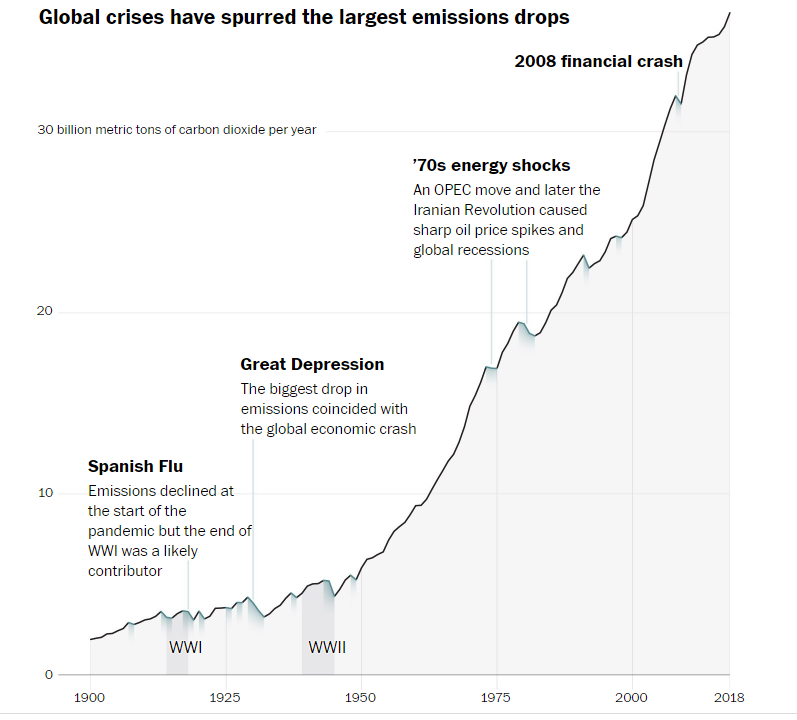
The last disease related slowdown, from 1918 to 1919 in the wake of the deadly Spanish Flu and the worst pandemic of the modern world — killing 50 million people around the world drove down emissions by more than 400 million tons of carbon dioxide in just one year.
A much needed breath of fresh air for our planetary lungs

Each year humans pump nearly 40 billion tons of carbon dioxide into the atmosphere and about 50 percent of these emissions are absorbed by plants in the terrestrial and ocean biospheres.
If this trend continues, analysts say it is possible this will lead to the first fall in global emissions since the 2008-09 financial crisis. Even a slowdown in CO2 could buy time for climate action and, more importantly, inspire long-term behavioral changes – particularly in travel and energy use. But, these brief trends mean nothing if we do not learn from our actions, learn from the past – and put everything we have into building a better future.
This Coronavirus outbreak and it’s effects on the global economy may give humans a brief respite in terms of Climate change, but only if we leverage this shift, and all future shifts to maximize our resiliency and ability for our communities and planets to weather extreme shock.
We have a brief window in which we must bring our emissions under what the planet can otherwise regulate and process.
Be on the Alert: Shock Doctrine Policy Measures.
Just as an aside. Be very careful of massive centralized responses, stimuli and relief efforts.
Stimulus packages will be designed to keep business as usual, to push the political agendas of current political groups in power, and to get industries back to where they were operating before the Corona-virus, no matter what it costs, and how many toxic assets will be transferred to taxpayers.
Academic Naomi Klein labels this the ‘shock doctrine’ that in that in times of extreme societal collapse, policies of privatisation, deregulation and cut backs to public spending are introduced and implemented that normally would never be passed – typically ‘shocks’ – either natural disasters or wars.
While before a crisis, a trillion dollars would be seen as a radical idea or notion, in the midst of a crisis when information is rapid, and people overwhelmed, policies and money is slammed through, often benefiting private or wealthy individuals, usually designed ultimately lead cuts for the very social safety net it’s supposed to be supporting to pay for the needed bailouts. This trend is worrying in that it establishes a repeating feedback loop in which Capitalism benefits from disaster, and comes out of each stronger than it did before.
We can do better.
Any true stimulus must be directed to, and by the communities they seek to serve. This includes grassroots, decentralized and community based responses, that can reward those taking the lead established by metrics and data, and maintained regularly in an accountable way. Which leads me to my final point.
We are undergoing a Tipping Point Event. Assess the data to demand a visionary future

As a society, we are more connected than ever before. However, until we learn to manage this connectivity better, these extreme disruptions are expected to become more numerous and severe. Based on projections for economic growth in 2020, the impact of the coronavirus might significantly curb global carbon emissions, but if this reduction is not coupled with real action to change our behaviors and invest in better ways of living, information from previous crashes has shown that these declines recover rapidly when the recession ends.
We are living in a small window to impact massive and structural change. Prudent evaluation and spending of recovery measures, permanent adoption of new behaviors and technology can influence how emissions evolve in future. Focus on community resiliency, on building the interconnections between organizers and groups that share similar missions, and realize we are all in this together.
As is the downfall for many centralized systems, we may waiting for a long time for the solutions we need. Our communities, and the amazing, intelligent and creative individuals – are not waiting – and are already crafting the solutions we need. Let’s not pretend that the system we were living in was perfect, and let’s not go into the trap of spending all of our energy to recreate it. Instead, let’s empower our communities, and ourselves, and let’s focus on the solutions we need.
Each time we face a systems level event is a time for rethinking and envisioning something new, and a better way.
Governments and markets right now are moving trillions of dollars and re-allocating billions of dollars in funding and priorities as the entire ways that our societies communicate, interact and what we call normal is redefined. In times of shock like this, we have an incredible power to create new paradigms.
It is up to each of us, and each of our communities to design what we may need as a society to create more regenerative, democratic, self-reliant and resilient to build bioregions able to resist system wide shocks in the future. We know our homes, communities and needs. We are the experts.
Right now, we have an opportunity to implement local and bioregional solutions that can lead to healthier, regenerative ways of living that are within the capacity of what the planet can support.
This means
- Decentralized & localized food networks, gardens, farms;
- Ways of living that maximize our health, our immune systems, are rooted in place and support diverse ecosystems and cultures of which we are part;
- Focus on micro grid, decentralized and standalone renewable energy;
- Economic models that are more circular than linear;
- Governing structures that are democratic, in which those most impacted have the biggest say;
- Bioregions as frameworks to design regions that are self reliant, regenerative and live within their own carrying capacities.
Every person should ask themselves, how can we inspire the collective action and mobilization of each person and community right now?
Brandon Letsinger is an open source advocate, bioregionalist, movement builder, founder of CascadiaNow!, the Department of Bioregion, and the Vice President of the Cascadia Association Football Federation. He is a historian, keynote speaker, leads bioregional mapping workshops and also runs Horizon Books in the Capitol Hill neighborhood of Seattle, WA.
Originally published on brandonletsinger.com. You can check out more at:
- https://twitter.com/cascadiabrandon
- https://instagram.com/cascadiabrandon
- https://deptofbioregion.org
- https://cascadia.community
- https://cascadiaunderground.org
If you would like to support this work, think about becoming grabbing a passport and flag by becoming a monthly patreon giver here.






Add comment